How to make ventilation in the country: subtleties and rules for installing ventilation of a country house
One of the main conditions for a comfortable stay in the room is the quality of the air we breathe. Therefore, it is very important to take care of how to make ventilation in the country, so that the air circulation meets the generally accepted requirements. It is obvious that too wet or dry microclimate can cause malaise and cause exacerbation of chronic diseases.
We do not visit the country house all the time, but seasonally: pensioners can spend six months there, and working summer residents visit a country house only on weekends, and sometimes during vacations. But this does not mean that living conditions should be worse than in a city apartment or cottage.
In the article, we talked about the rules for arranging ventilation in a country house and gave brief installation instructions that are useful to those who want to improve the microclimate of the country house with their own hands.
The content of the article:
Do I need ventilation in the country?
Skeptics will say: why spend time installing additional devices, if the cottage is a house for temporary, short stays.
Several nights, especially in the summer, can be spent with an open window leaf, here's the ventilation.

In fact, comfort is not only in the fresh air. This is normal humidity, and favorable conditions for storing fresh vegetables and preparations, with quick drying of wet clothes, and the absence of mold, with which a musty smell settles in the house.
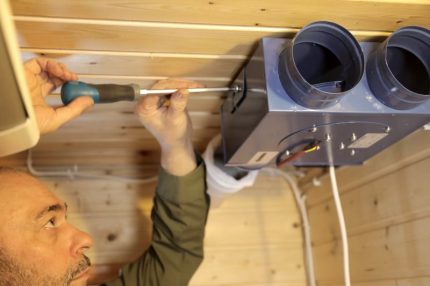
How to determine that the air is stagnant and not circulating? Here are some obvious signs:
- condensate on the window panes, streaming down the drain on the windowsill;
- pockets of mold on the walls, in corners or on the ceiling;
- wallpaper lagging behind the walls, dry furniture;
- persistent "aroma" of mold and musty;
- cool, unpleasant atmosphere arising from high humidity even in a warm room.
Things in such a house practically do not dry out, some bugs and wood lice constantly crawl along the walls.
There are many ways to quickly fix an unattractive situation. Often, you just need to install a device or device that helps air to enter / leave the room.
Here are some of these devices:
Even by installing one of the listed devices, you will immediately notice the difference: dampness will disappear from the house, there will be no need to arrange drafts for ventilation.
Natural or forced - which is better?
By the method of inducing air, ventilation is divided into natural, occurring without the intervention of the owners of the house, and artificial or forced, organized with the help of fans and ducts.
The simplest example of natural ventilation is an apartment in a house with wooden windows. The hood, although organized during construction, is subject to the laws of physics, and air is supplied through slots in window and door openings, open windows and windows.
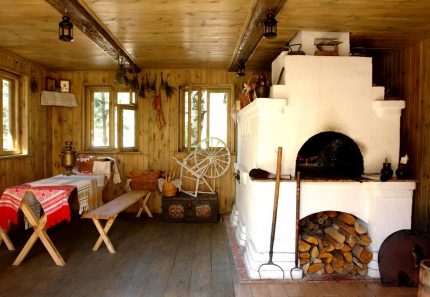
But sometimes, natural air exchange is not enough to form a healthy, comfortable living environment. And then you have to use the above devices, embed new ones ventilation ducts.
As ducts use or plastic pipes or galvanized elements. They are located above the suspended structures and in the walls with access to the outside over the roof or in the wall.
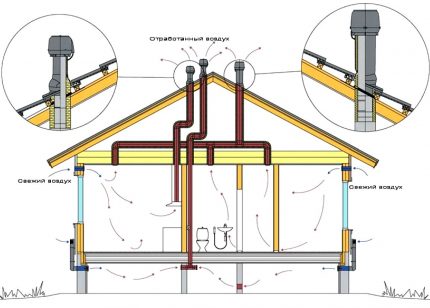
The best way to get proper ventilation is through a combination of natural and mechanical ways to improve air circulation. From this side, the country house does not differ from the usual city apartment: to the half-open window you can add the installation of a fan in the toilet and the installation of an inexpensive hoods in the kitchen.
Simple do-it-yourself solutions
Of course, to improve the microclimate in the country house, it is unlikely that anyone will demolish the walls to equip full-fledged ventilation shafts. However, some useful changes can be made, and all the work is easily performed on their own, and instruments and devices are purchased for a reasonable price.
We offer several popular options, which, having tried to equip at the cottage, you can implement in a more serious home.We will figure out how to make supply and exhaust ventilation in a country house, without fundamentally redrawing the layout.
Option # 1 - Improving Natural Circulation
Knowing that for a healthy microclimate a certain volume must enter the room and the same volume out of it, you can simply create more favorable conditions for natural circulation.
As an example, take a small wooden country house of a traditional construction, with a gable roof, stove and wooden windows.
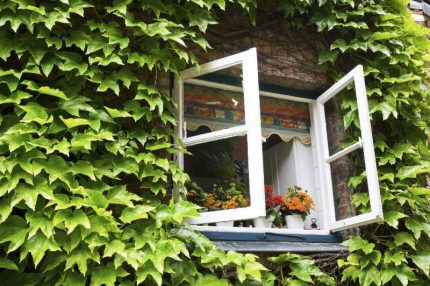
What can be done to activate air intake / exhaust or at least not to impede it? It is necessary to ensure that the stove flaps open on time, and the pipe is protected by a hood. It is also recommended to monitor the cleanliness of the chimney.
If you plan to install plastic windows instead of wooden, keep in mind that you will have to organize forced ventilation in some other way. Perhaps the old casement just needs to be sanded and painted, and then replacement is not required.
If there are interior doors, air moves freely under them. Do not rush to set thresholds - they interfere not only with the movement of residents, but also with air circulation.
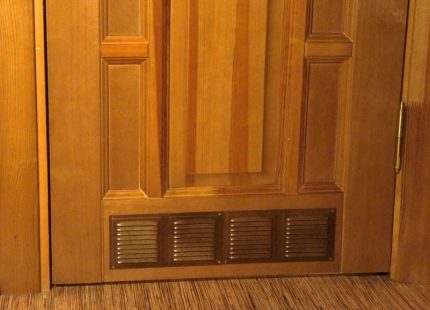
Do not think that good ventilation comes into conflict with the insulation of the house: properly adjusted air circulation does not violate the thermal regime.
Option # 2 - mounting an axial fan
One of the best ways to reduce humidity in the room and remove unpleasant odors is to install a fan. If a ventilation shaft is installed in the house, or at least a pipe is walled up in the wall, the fan is mounted in the finished hole. If not, get a special window model and insert it into the window.
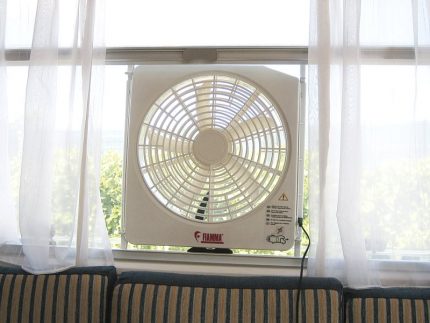
It should be remembered that the fans are connected to the mains, so its presence in the country is mandatory.
To connect, you need a fan itself, VVG wires 3 * 1.5, a switch.
Consider how and in what sequence to extract the hood in the country:
- Preparing a seat. The minimum hole diameter is 10 cm.
- Choice of connection scheme - for 1- and 2-key switches, as well as for devices with a timer, they will differ.
- Check the traction in the channel - if it is not there, you need to clean it.
Next, you need to remove the cover from the device, and the remaining "working" part to fix on the wall using screws or sealant.
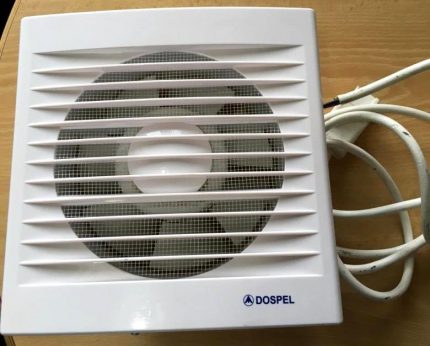
We proceed further:
- we bring wires from the switch and the junction box, expose the ends, insert into the corresponding terminals and twist;
- install the switch in a pre-prepared socket, pre-connecting the wires to it;
- testing fan operation;
- put on and fasten the decorative panel.
We select the scheme depending on the conditions of use.

The fan can be installed in the kitchen, in the toilet, and in any room of the cottage, where conditions permit and there is a ventilation duct or hole leading to the street.
Option # 3 - installing a supply valve
If you don’t want to spoil the window construction, but there is no special ventilation shaft in the house, then instead of a fan you can install wall inlet valve.
The installation location is to the right / left of the window, at a height of 2-2.2 m. There is another option - under the window, but this is with a heating radiator.
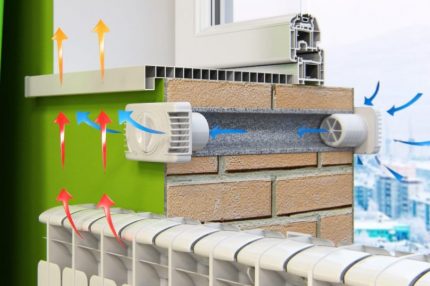
The valve does not take up much space; it can be covered with a curtain inside the room. An external grill protects the device from debris and dust, and also reduces the noise level produced by rain, strong winds or passing vehicles.
Assembly instruction:
- Check the operation of the exhaust ducts, which provide the functionality of the supply ventilation.
- Determine the place near the window for making a hole, make sure that there are no fittings or wiring in the wall.
- Install a drill bit of the desired diameter on the drill — slightly larger than the diameter of the valve.
- Drill a hole. Use a construction vacuum cleaner to collect dust.
- Wet the hole in the wall with cold water to cool the crown.
- Clean the hole, insert the insulation tube.
- Push the air duct inside the tube.
- On the outside, at the outlet of the duct, fasten the decorative grille with an acoustic visor.
- Install a valve on the inside of the mounts.
- Check the operation of the shutter and the presence of traction.
The simplest device for forced ventilation only works in conjunction with a well-established hood.
Option # 4 - arrangement of ventilation in the basement
Country cellars are often used for its intended purpose - to store the crop in a fresh and canned form. For vegetables and fruits, a cool but dry microclimate is needed, and excess moisture is destructive, so ventilation is simply necessary.
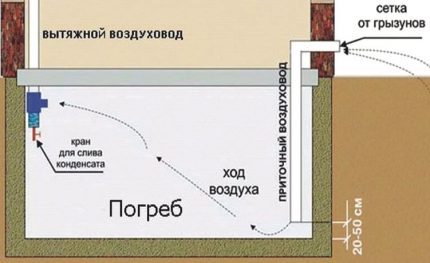
If the ducts are not installed during the construction of the house, they can be equipped later, but you will have to work hard by making holes in the ceilings.
Device Features:
- pipes should have the same diameter;
- you need to arrange the channels in opposite angles;
- the exhaust hole of the duct should be placed under the ceiling, to eliminate stagnant air;
- the height of the pipe above the ridge of the roof is at least 1.5 m;
- plastic sewer pipes are suitable for a small basement;
- you need to try so that the pipes are placed strictly vertically, without turns.
The top of the pipe must be protected from rain and debris.
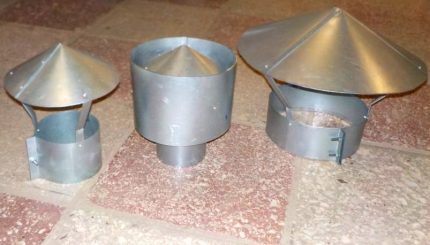
If natural ventilation can not cope, in the basement, as in the kitchen or in the bathroom, a fan is installed. For capital drying of the premises using an electric radiator or other heating device.
In summer, in dry weather, you can arrange a draft, and for the winter, install a box with sea salt, which absorbs excess moisture.
More information about the ventilation of the cellar can be found in this stuff.
Conclusions and useful video on the topic
Installing a fan in the wall of a frame house:
Elements of ventilation in a house under construction - personal experience:
Video instruction for installing the supply valve:
Inadequate air circulation causes many problems: colds, fast food spoilage, unpleasant stagnant odors. Air exchange can be improved with the simple solutions presented above. A few hours of work, and the atmosphere in the house will become much warmer and more comfortable!
If you are interested in building requirements, take a look at SNiP 41-01-2003, and more about fans can be found in GOST 11442-90.
Still have questions, find flaws, or can you supplement our material with valuable information on the arrangement of ventilation in a country house? Write your comments - the contact form is located under the article.

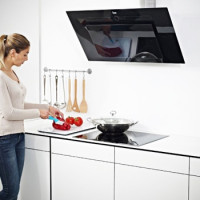 Air vents for a kitchen with a vent in the ventilation: working principle, diagrams and installation rules
Air vents for a kitchen with a vent in the ventilation: working principle, diagrams and installation rules 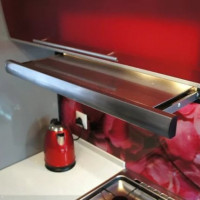 Hood without venting to ventilation: principle of operation, typical schemes and installation rules
Hood without venting to ventilation: principle of operation, typical schemes and installation rules 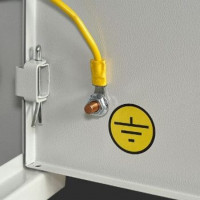 Grounding the ventilation system: rules and subtleties of the protective circuit device
Grounding the ventilation system: rules and subtleties of the protective circuit device  Duct-mounted ducted air conditioner: subtleties of choice and installation
Duct-mounted ducted air conditioner: subtleties of choice and installation 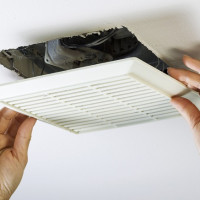 How to get rid of condensate in the ventilation pipe: the subtleties of eliminating drops from the duct
How to get rid of condensate in the ventilation pipe: the subtleties of eliminating drops from the duct 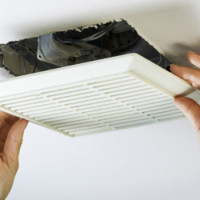 How to check ventilation in an apartment: rules for checking ventilation ducts
How to check ventilation in an apartment: rules for checking ventilation ducts  How much does it cost to connect gas to a private house: the price of organizing gas supply
How much does it cost to connect gas to a private house: the price of organizing gas supply  The best washing machines with dryer: model rating and customer tips
The best washing machines with dryer: model rating and customer tips  What is the color temperature of light and the nuances of choosing the temperature of the lamps to suit your needs
What is the color temperature of light and the nuances of choosing the temperature of the lamps to suit your needs  Replacement of a geyser in an apartment: replacement paperwork + basic norms and requirements
Replacement of a geyser in an apartment: replacement paperwork + basic norms and requirements